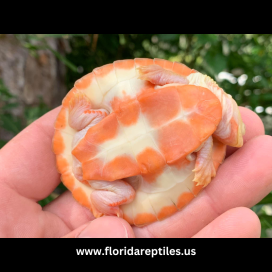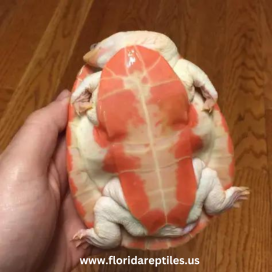- You have no items in your shopping cart
- Subtotal: $0.00
Albino pink belly turtle are native to the southeastern United States, where they can be found in a variety of aquatic habitats including rivers, streams, and swamps. They prefer slow-moving water with plenty of vegetation for cover and basking areas to soak up the sun. In captivity, they require a similarly designed habitat with a basking area, a filter, and a heat source to maintain a suitable water temperature of around 75-80°F.
Albino pink belly turtles are omnivores, meaning they eat both plant and animal matter. Their diet in the wild includes aquatic plants, algae, insects, and small fish. In captivity, they should be fed a balanced diet that includes a variety of commercial turtle pellets, fresh vegetables such as kale and collard greens, and occasional protein sources such as mealworms or cooked chicken.
Buy Albino Pink Belly Turtle on Florida Reptiles
If you’re a fan of turtles, you may have heard about the albino pink belly turtle. This unique and fascinating species of turtle is a popular pet among reptile enthusiasts, thanks to its striking appearance and interesting behavior. You can buy this magnificent creature at www.floridareptiles.us. In this article, we’ll explore the world of albino pink belly turtles, from their physical characteristics and habitat to their diet and behavior.
What is Albino Pink Belly Turtle?
Albino pink belly turtles are a species of turtle that is known for its striking pink coloration on its belly. They are a variant of the common pink belly turtle, also known as the red-bellied turtle, and can be found in the wild in the southeastern United States. Albino pink belly turtles are born without melanin, which gives them their unique pink coloration.
a) Physical Characteristics:
Albino pink belly turtles are small to medium-sized turtles, with an average shell length of 5-7 inches. They have a distinctive pink coloration on their belly, while their shells are usually a light tan or beige color. Their eyes are red, and they have small, pointed noses. Albino turtles are also known for their webbed feet, which help them to swim.
b) Habitat:
Albino pink belly turtles are native to the southeastern United States, where they can be found in a variety of freshwater habitats, including ponds, lakes, and rivers. They prefer slow-moving bodies of water with plenty of vegetation, where they can find food and shelter. Albino turtles are also known to bask on logs or rocks in the sun, which helps to regulate their body temperature.
c) Diet:
Albino pink belly turtles are omnivores, which means they eat both plants and animals. In the wild, their diet consists of a variety of aquatic plants, insects, fish, and small invertebrates. In captivity, they can be fed a diet of commercial turtle pellets, as well as fresh fruits and vegetables. It’s important to provide albino turtles with a balanced diet that meets their nutritional needs.
d) Behavior:
Albino pink belly turtles are social animals that are often found in groups in the wild. They are also known for their curious and active behavior, and can often be seen swimming or basking in the sun. Albino pink-belly turtles are also known for their strong sense of smell, which they use to locate food.
e) Care and Maintenance:
If you’re considering keeping an albino pink belly turtle as a pet, it’s important to provide them with a suitable habitat. This includes a large aquarium or terrarium with plenty of water and land areas, as well as a basking area with a heat lamp. Albino pink belly turtles also require a UVB light to help them metabolize calcium, which is important for their shell health.
f) Breeding:
Albino pink-belly turtles can be bred in captivity, but it’s important to have a good understanding of their needs and behaviors before attempting to breed them. Female pink-belly turtles lay their eggs on land, usually in a nest that they dig themselves. The eggs take around 60 days to hatch, and the baby turtles are fully independent of birth.
https://youtube.com/shorts/__CVilHbMLY?feature=share
Is it legal to Buy Albino Pink Belly Turtle as a Pet?
The legality of owning an albino pink turtle as a pet can vary depending on your location. In some states or countries, it may be illegal to own certain species of turtles or to purchase them from certain sources. It’s important to research the laws and regulations in your area before purchasing an albino pink belly turtle to ensure that you are doing so legally. Additionally, it’s important to make sure that the turtle you purchase was legally obtained and is not a protected or endangered species.
Where to find Albino Pink Belly Turtle for Sale
If you’re interested in owning an albino turtle, there are a few places where you can find them for sale. Pet stores and reptile expos are common places to find these turtles. But you can also purchase them online from reputable breeders like floridareptiles.us. It’s important to do your research and make sure you’re purchasing from a trustworthy source to ensure the health and well-being of your turtle.
Factors to Consider Before Purchasing an Albino Pink Belly Turtle
Before purchasing an albino pink belly turtle, it’s important to consider a few factors. These turtles require specific care and maintenance, so you’ll need to make sure you’re able to provide them with a suitable habitat, balanced diet, and UVB lighting. Additionally, you’ll want to consider the cost of purchasing and caring for a turtle, as well as the time and effort required to properly care for them.
How to Choose a Healthy Albino Pink Belly Turtle
When purchasing an albino turtle, it’s important to choose a healthy individual to ensure they will thrive in their new home. Look for turtles with clear, bright eyes and smooth, unblemished shells. They should be active and alert, with no signs of lethargy or illness. Additionally, make sure to ask the breeder or store about the turtle’s history and any potential health issues to be aware of.
The Cost of Albino Pink Belly Turtles for Sale
The cost of albino pink belly turtles can vary depending on where you purchase them from and the individual’s age and size. Generally, you can expect to pay anywhere from $50 to $300 for a healthy, captive-bred turtle. Keep in mind that there are additional costs associated with owning a turtle, such as purchasing a suitable enclosure, food, and lighting. It’s important to budget accordingly to ensure you can provide your turtle with everything they need.
Conclusion
Albino pink belly turtles are a unique and fascinating species of turtle that are popular among reptile enthusiasts. Their striking pink coloration and interesting behavior make them a popular choice for pets, but it’s important to provide them with suitable habitat and diet. By understanding the needs of albino pink-belly turtles, you can enjoy these beautiful and interesting creatures as pets.
FAQs
Can albino pink belly turtles live with other turtles?
Are albino pink belly turtles easy to care for as pets?
How can I tell if my albino pink belly turtle is male or female?
Do albino pink belly turtles hibernate?




